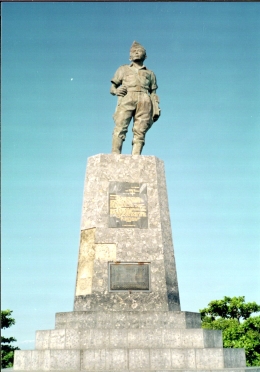Modern History of Bali

I thought this was an uncommonly concise summary of Bali's post war history from a great little site, Bali Plus:
"On February 18th, 1942, a small force of Japanese soldiers landed at Sanur, and took over from the demoralized Dutch garrison. The victorious Japanese ruled Bali for three years, very much in accordance with the already established Dutch system. They did not actively intervene in Balinese affairs, but the effects of their compulsory requisition of rice and foodstuff were far-reaching and by the time the war ended the Balinese were suffering from severe privations and facing both famine and epidemic.
During the Japanese occupation, which fostered a repressive atmosphere ripe for rebellion, a charismatic young military officer, Gusti Ngurah Rai [pictured], began to gather together a Balinese 'freedom army'. He took the remnants of the military forces, combined them with new recruits and volunteers began training them in soldiery and tactics. His motto, 'merdeka atau mati', freedom or death , was to ironically seal his fate as both hero and martyr of the independence movement.
The bombing of Hiroshima and Nagasaki resulted in the capitulation of the Japanese High Command, and on August 17, 1945, Sukarno and Mohammad Hatta declared Indonesia to be an independent nation. The remaining Japanese in Bali withdrew, and the local Balinese leaders moved quickly to occupy the provincial offices and residences.
The Dutch, however, were not yet willing to relinquish their pre-war powers. They arrived back in force and proceeded to make arrests, attempting to re-establish the colonial administration, meeting with unexpected resistance from Ngurah Rai and his followers. After a series of guerilla type confrontations which served to arouse the wrath of the Dutch, Ngurah Rai finally rallied his forces in east Bali at Margarana, where they made a suicide attack on the heavily armed Dutch. The Balinese battalion was entirely wiped out, breaking the last thread of Balinese military resistance.
In 1946 the Dutch constituted Bali one of the 13 administrative districts of the Republic of East Indonesia, a rival state to the revolutionary republic headed by Sukarno and Hatta. Continued rebellion in Java, however, finally induced the Hague to concede Indonesian independence. Bali became part of the Republic of the United States of Indonesia on Dec. 29, 1949. In 1956 Bali renounced the Dutch union and became a province within the Republic of Indonesia.
Transition from colonialism to independence was not easy, and by 1956 the whole of Indonesia, led by the charismatic President Sukarno, was undergoing a tumultuous, difficult period. Economic conditions had seriously deteriorated and the Communist party was growing in power. Rice was in short supply, and inflation was rife. In 1962 an extremely bad omen augured further disaster. Plagues of rats infested the island's fields and granaries. In early 1963, as the people of Bali began to prepare for the celebration of Eka Dasa Rudra, the most sacred of all Balinese temple festivals, signs were still particularly ominous, and the priests and elders were gravely concerned.
On February 18th, 1963, Besakih temple was being readied for an influx of devotees and official guests when Mt. Agung suddenly began to spurt ash and smoke, and earthquakes shook the island.
On March 12th, in the midst of ceremonies at Besakih, the volcano, for centuries dormant, began spewing mud and rock and by the end of the week great rivers of molten lava were flowing down the mountainside. Smoke and volcanic ash darkened the island under a grey cloud. The Besakih temple complex miraculously escaped the main line of destruction, although many of the thatched shrines were burnt, and the entire complex was buried in deep layers of ash. Many died, and for months famine prevailed over wide areas. Entire villages were wiped out, and thousands of hectares of farmland ruined.
The worst was not yet over. The island was in the throes of recovery in late 1965 when the Communist Party staged an abortive coup d'etat in Jakarta, and reprisals began all over Indonesia as the Nationalists set out to extinguish all traces of communism. Bali was the scene of incredible violence, and thousands of people were killed.
The terrible events of the early and middle 60's are rather forgotten by the Balinese, who prefer not to dwell on the past. With the government of President Suharto, major reforms in the administration have been carried out. Indonesia is in the throes of a vigour of development to which Bali contributes considerably as a rich source of international tourism. The Government is wisely trying to limit negative effects of this influx, at the same time as encouraging benefits such as the revival of many of the performing arts." Bali
1 Comments:
nice article
eksotisme pulau bali dalam lensa vga...hehe
http://learningfromlives.wordpress.com/2012/01/07/3-hari-di-pulau-bali/
Post a Comment
<< Home